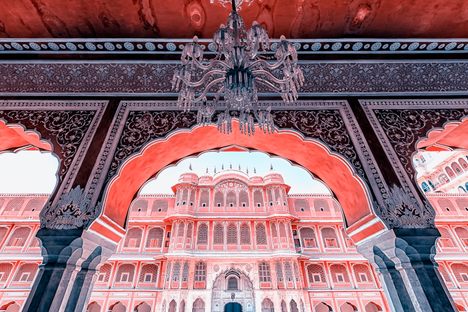On hot summer days, friends and families gathered at Indian cafes slurp down tall glasses of falooda using long, slender spoons.
In any assemblage of this icy drink-meets-dessert, diners will find a tangle of rice vermicelli and basil seeds sitting in frosty, rose syrup–tinted milk. Pistachios, almonds, and ice cream often finish off the parfait, adding crunchy and creamy elements to the gooey, fragrant combination. As with many of the frozen hodgepodges made from locally-available goodies (see: Filipino halo-halo, Taiwanese bao bing, and Colombian cholado), variations abound. Aside from rose syrup, flavors such as grape, orange, pineapple, and black currant are just a few of the other options found in cafes across the country.
Locals in Mumbai are often credited with the modern iteration of this signature sweet, but the creation is beloved by Indians all over the world. Today, falooda stalls selling plastic to-go containers line the country’s beaches, but many believe it descended from royalty. According to one food historian, a 17th-century Mughal emperor had a particular penchant for “faluda, a rich jelly-like drink made from the strainings of boiled wheat mixed with fruit juices and cream.”
No matter what form falooda takes, all variations stem from faloodeh, a Persian dessert made from frozen vermicelli soaked in a rose syrup, which has been enjoyed for more than 2,500 years. Persians began arriving in India during the 8th century, so faloodeh had plenty of time to catch on, attain royal status, and then morph into a popular milkshake-like dessert, all while retaining almost exactly the same name.
Where to Try It
-
Badshah Cold Drinks
52/156, Umrigar Building, Opp. Crawford Market, Lokmanya Tilak Marg, Mumbai, 400003, IndiaThis Crawford market outpost is renowned for its not-too-sugary falooda.
-
Falooda is also a popular dessert drink in Burma. This Burmese grocery store serves up their own signature twist on it.
Written By
 SeemaKg
SeemaKg
Sources
- thecitystory.com/badshah-falooda-crawford-market-mumbai/
- www.thespruceeats.com/shahi-falooda-drink-dessert-1957844
- www.spiceupthecurry.com/falooda-recipe/
- newyork.seriouseats.com/2011/08/a-week-of-icy-treats-in-queens-day-one---kulf.html
- www.npr.org/sections/thesalt/2016/09/08/492139092/in-this-globe-trotting-dessert-many-immigrants-find-a-taste-of-home
- food.ndtv.com/food-drinks/the-story-of-falooda-a-drink-or-dessert-1235124
- books.google.com/books?id=BGhBAgAAQBAJ&pg=PT108&dq=falooda+mughal&hl=en&sa=X&ved=0ahUKEwiC5ZXc8obgAhVin-AKHT_DCo4Q6AEIKDAA#v=onepage&q=falooda%20mughal&f=false
- books.google.com/books?id=LTx4ZiPJbmcC&pg=PT211&lpg=PT211&dq=Emperor+Jahangir+falooda&source=bl&ots=bBQDoDpyA_&sig=ACfU3U1w5CYVaFDKE0nUQPj6VJumOGNnCw&hl=en&sa=X&ved=2ahUKEwiL252m84bgAhUEGt8KHfRwARw4ChDoATAEegQIARAB#v=onepage&q=Emperor%20Jahangir%20falooda&f=false















